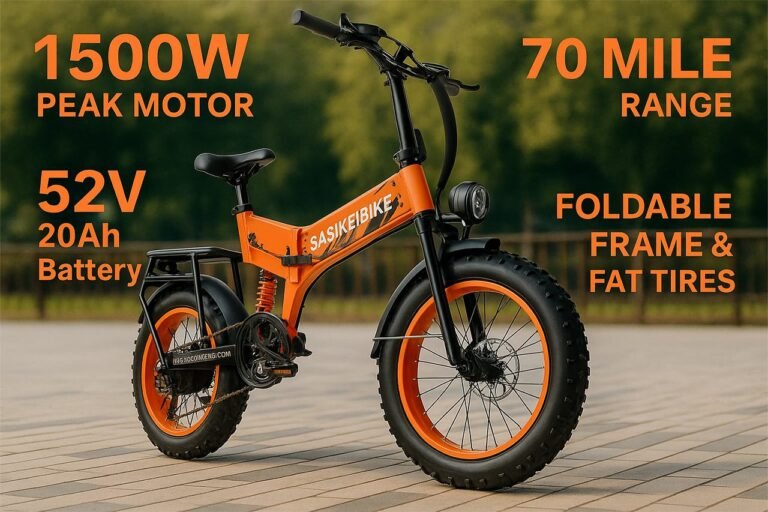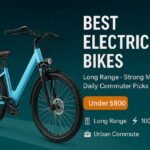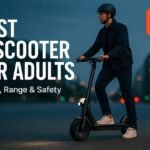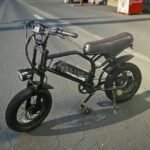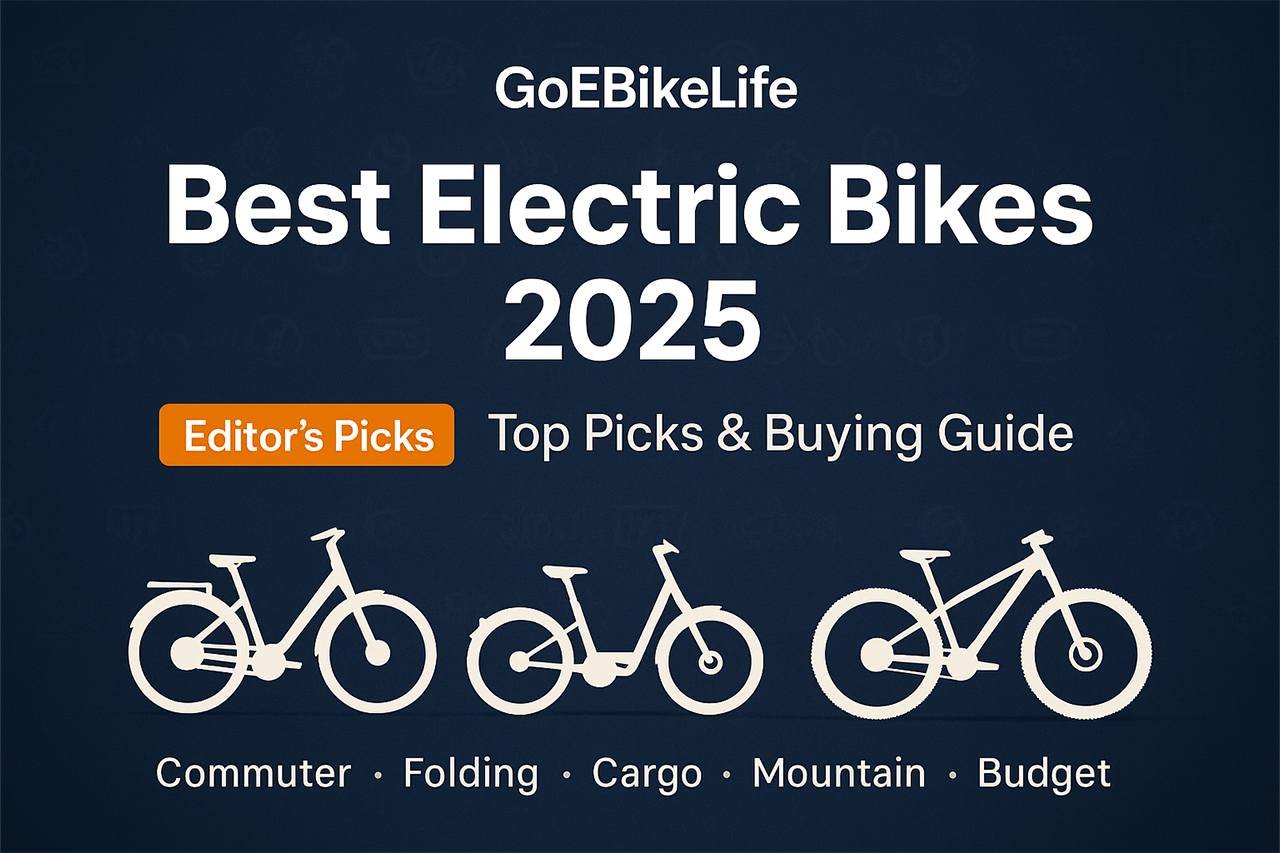
If you’re hunting for an e-bike in 2025, you’re spoiled for choice—and also drowning in hype.
This guide cuts through the noise with six clear picks by use-case, followed by a no-nonsense buying framework: how to match motor type and battery size to your terrain, what range to expect in the real world, which certifications actually matter, and the accessories that make or break daily ownership.
Quick picks (by category)
- Best Overall: FREESKY Swift Horse Pro — huge battery, serious torque, and dual suspension without an absurd price tag.
- Best for Commuting: Cybervelo EK2 — value city bike with 1000W (peak) hub, long claimed range, 26” wheels for a stable urban ride.
- Best Mountain E-Bike: TUTTIO ADRIA26 — dual-motor brute (up to 5,000W peak) for steep fire roads and rough trails. (Off-road oriented; check your local regulations.)
- Best Folding E-Bike: Cybervelo EK4 — compact step-through folder with big 48V/20.8Ah battery and a claimed 30+ mph top end.
- Best Cargo E-Bike: TST K002 — step-through cargo rig with basket, rails, and 750W (1,500W peak) motor for family hauling.
- Best Budget Pick: ZDZA ZA04 — starter 26” MTB/commuter with 1000W (peak) hub, 375Wh battery, and UL 2849 system certification.
How to choose the right e-bike (fast)
1) Start with where you ride
- Flat city → 250–500W nominal hub motor is fine; prioritize comfort, fenders, lights, racks.
- Hilly suburbs → 500–750W nominal hub (or mid-drive with decent torque).
- Off-road/trails → mid-drive or high-torque hub, suspension that actually works, and powerful brakes.
- Cargo/kid-carry → longtail or step-through cargo frame, strong wheels/tires, and low-gear range.
2) Understand USA e-bike classes
- Class 1: Pedal assist only, up to 20 mph.
- Class 2: Throttle allowed (plus PAS), up to 20 mph.
- Class 3: Pedal assist up to 28 mph (often speedometer required; throttle rules vary by state).
Check your state’s rules before you buy; access to bike paths varies.
3) Match battery to range (and your weight/terrain)
Battery capacity (watt-hours, Wh) ≈ Voltage × Amp-hours.
Real-world consumption typically runs 12–25 Wh/mi on a city bike, 20–35 Wh/mi for trail/cargo, rising with weight, hills, wind, and speed. A 375Wh pack at ~15 Wh/mi ≈ 25 miles of mixed PAS; at 25 Wh/mi ≈ 15 miles. Marketing ranges assume light riders, low PAS, and ideal conditions.
4) Brakes, tires, and suspension matter more than flashy wattage
- Hydraulic discs give better modulation and require less hand force than mechanical.
- Fatter tires (2.4–4.0”) add comfort and grip at lower pressures.
- Cheap suspension forks (and seatposts) can fatigue or chatter—look for adjustable lockout, and realistic stanchion size.
5) Safety & certification (don’t skip this)
In the U.S., UL 2849 covers the e-bike electrical system (drive unit, battery, charger interop). UL 2271 covers battery packs themselves. NYC and some employers require these; even where it’s not mandated, it’s a meaningful safety signal. The CPSC has been moving toward tighter micromobility battery rules—another reason to prefer compliant systems.
The winners (and why)
Below are straight-talk reviews you can use on your money page. “Claimed” indicates manufacturer-quoted specs; expect real-world range to be lower depending on rider weight, terrain, temperature, and wind.
Best Overall: FREESKY Swift Horse Pro (X-6E)
Why it wins: It checks nearly every box serious riders care about—big 48V/30Ah Samsung pack, 2000W peak Bafang hub with ~130 Nm torque, dual suspension, 4-piston hydraulics, and a stated UL 2849 electrical system with UL 2271 battery. For mixed city + trail riders who want power and range without a premium-brand price, this is the most well-rounded build of the bunch.
Key claims
- Motor: Bafang rear hub, 2000W peak, ~130 Nm
- Battery: 48V 30Ah Samsung; claimed 75–120 mi PAS
- Speed: up to 35 mph (PAS), 20 mph by throttle (set your class appropriately)
- Brakes: 4-piston hydraulic
- Safety: UL 2849 (system) and UL 2271 (battery) indicated on product page
- Fit: riders 5’3″–6’5″; load ~300 lb
Best for: Riders who want one bike that can commute fast, cruise on weekends, and handle sketchy pavement or light trails—without range anxiety.
Watch-outs: Heavy with that huge battery; check local speed/class limits to stay legal.
Best for Commuting: Cybervelo EK2
Why it wins: For commuters, the EK2 hits the value sweet spot: peak 1000W hub for headwinds/hills, claimed up to ~80+ mi range, color LCD with multiple PAS levels, and full commuter practicality on 26” wheels (stable handling, easy tire availability). Pricing routinely dips to budget territory.
Key claims
- Motor: 1000W peak hub; 7-speed drivetrain
- Range: up to ~80–85+ mi (marketing claim)
- Speed: 25+ mph (listed)
- Comfort & control: adjustable front fork, saddle shock absorption, dual mechanical discs + EABS
- Assembly: arrives ~90% pre-built; support advertised 24/7
Best for: Cost-conscious commuters who still want punch up moderate hills and don’t need fat tires or dual suspension.
Watch-outs: Mechanical (not hydraulic) brakes at this price. Treat range claims conservatively; assume ~20–40 miles PAS for heavier riders/real traffic.
Best Mountain E-Bike: TUTTIO ADRIA26 (Dual-Motor)
Why it wins: It’s unapologetically overbuilt: dual motors (up to 5,000W peak combined), 52V 30Ah headline battery (spec table lists 25Ah) and an off-road-leaning chassis (26×4.0” tires, hydraulic discs, front + rear suspension). It’s for steep climbs and loose terrain—not for mellow bike paths. UL language and off-road notices are clearly stated by the brand.
Key claims
- Motor: dual hubs, 5,000W peak (2×2,500W)
- Battery: page headline 52V 30Ah; spec table 52V 25Ah (verify before purchase)
- Speed: 40–46 mph claimed (off-road context)
- Range: up to 100 miles PAS stated in copy; spec table shows 32 mi at test weight—discrepancy flagged
- Brakes & suspension: hydraulic discs, lockable front fork + rear shock
- Stated certification: “UL Certification” mention; check for actual UL 2849 certificate on the finished bike if your jurisdiction requires it.
Best for: Experienced riders on steep gravel/fire roads who want raw climbing/braking power.
Watch-outs: Very powerful; may not be street-legal as Class 1/2/3. Heavier than commuter bikes. Marketing vs. spec-table inconsistencies—confirm battery capacity and system certification.
Best Folding E-Bike: Cybervelo EK4
Why it wins: Folders usually trade capacity for convenience; the EK4 keeps the convenience while packing a 48V 20.8Ah battery and peak 1000W hub in a step-through, foldable frame. If you need to store a bike in a small apartment or trunk and still want respectable speed, this is it.
Key claims
- Motor: 750W nominal (1000W peak), 7-speed
- Battery: 48V 20.8Ah removable; claimed 80+ miles
- Speed: 30+ mph listed (set class limits appropriately)
- Package: hydraulic? (brakes listed as dual discs; site calls out double discs + EABS), front fork + seatpost suspension; 20″ fat tires
- Foldable step-through frame; LCD with charge port
Best for: Apartment dwellers, RV travelers, last-mile commuters who still want a big battery.
Watch-outs: 20″ fat tires ride differently from 26–29″—more nimble but can feel busy at speed. Check weight if you’ll carry it upstairs.
Best Cargo E-Bike: TST K002 (Cargo Step-Through)
Why it wins: Out of the box you get a rear rack, basket, guard rails, footrests, and a step-through frame—exactly what family/cargo riders need. The motor is 750W nominal (1,500W peak) with a 48V 15Ah battery, and the listing cites a 450 lb max load. It’s a pragmatic hauler at a sensible price.
Key claims
- Motor: 750W nominal (1,500W peak) hub; ~90 Nm torque claimed
- Battery: 48V 15Ah, 60 mi PAS claim
- Speed: up to 28 mph stated
- Max load: up to 450 lb (listing)
- Safety note: listing references a “UL certified” removable battery; check for full UL 2849 system compliance if needed.
Best for: School runs, groceries, parks, or delivery use where stability and carrying options are top priority.
Watch-outs: Small cargo bikes with 20″ fat tires can have quicker steering—practice loaded braking and cornering before carrying passengers.
Best Budget Pick: ZDZA ZA04
Why it wins: It delivers the basics that matter—1000W (peak) rear hub, 375Wh removable battery, claimed 22 mph top speed, dual disc brakes, 7-speed drivetrain—and it’s one of the few budget models that explicitly cites UL 2849 system certification on retail pages. Ideal as a first e-bike or a secondary commuter.
Key claims
- Motor: 1000W peak rear hub; 22 mph top speed claim
- Battery: 375Wh removable; ~40 miles PAS claim
- Frame & fit: 26″ wheels; carbon-steel triangle; max 265 lb stated
- Safety: UL 2849 system noted in product copy (verify labeling on shipped unit)
Best for: New riders and budget-minded commuters who want a simple, serviceable setup and verified system-level safety language.
Watch-outs: Modest battery means realistic PAS range closer to ~15–30 miles for heavier riders/hilly routes. Mechanical discs on most listings.
Spec snapshot
| Model | Motor (peak) | Battery (V/Ah or Wh) | Top speed (claim) | Range (claim) | Brakes | Notes |
|---|---|---|---|---|---|---|
| FREESKY Swift Horse Pro | 2000W | 48V / 30Ah | 35 mph PAS (20 mph throttle) | 75–120 mi PAS | 4-piston hydraulic | UL 2849 system + UL 2271 battery noted. Dual suspension. |
| Cybervelo EK2 | 1000W | (not listed in Ah on page) | 25+ mph | up to 80–85+ mi | Mechanical discs + EABS | Value commuter. 26″ wheels. |
| TUTTIO ADRIA26 | 5000W dual | 52V 30Ah headline / 25Ah in spec table | 40–46 mph | up to 100 mi in copy; 32 mi in spec table | Hydraulic discs | Off-road orientation; confirm battery spec & certification. |
| Cybervelo EK4 (folding) | 1000W | 48V / 20.8Ah | 30+ mph | 80+ mi | Dual discs + EABS | Foldable step-through; 20″ fat tires. |
| TST K002 (cargo) | 1500W | 48V / 15Ah | 28 mph | 60 mi PAS | (varies by listing; discs) | Basket + rails; 450 lb max load claim. |
| ZDZA ZA04 (budget) | 1000W | 375Wh | 22 mph | 40 mi PAS | Dual discs | UL 2849 system noted; starter MTB/commuter. |
Important: Specs above are manufacturer claims. Real-world range depends on rider + cargo weight, terrain, temperature, wind, and PAS level. Always check labeling on the delivered bike for class settings and safety certifications.
Buying framework (deeper dive)
Motor types: hub vs. mid-drive
- Rear hub motors dominate budget–midrange bikes: simple, low-maintenance, great for commuting. They apply power at the wheel, so you don’t multiply torque through the gears.
- Mid-drives (not in this list) power through the chainring, using your gears for climbing efficiency and better weight distribution—ideal for serious off-road or very steep cities—at a price and maintenance premium.
- Dual-motor (front + rear hub) systems like ADRIA26 bring brute force and traction off-road but add weight and complexity.
Power & torque (what the numbers really mean)
- “Peak watts” is a burst figure; continuous/nominal watts (rarely advertised) better predict sustained climbing heat-soak.
- Torque (Nm) describes low-speed shove. For hills/cargo, torque + gearing matters more than headline watts (Swift Horse Pro’s ~130 Nm is why it feels effortless on grades).
Battery, range, and charging
- Prefer branded cells (Samsung, LG, Panasonic) and packs with provable UL 2271 compliance; even better when the entire system is listed to UL 2849.
- Rule-of-thumb range:
- Flat city @ 15–18 mph, 180–200 lb rider → 12–18 Wh/mi
- Hilly city/suburbs or cargo → 18–30 Wh/mi
- Off-road sand/snow → 25–40 Wh/mi
Multiply your estimated Wh/mi by your route to pick a battery.
Brakes & rubber
- If you ride faster than ~20 mph regularly or carry passengers/cargo, hydraulic discs become non-negotiable (modulation, lever feel, wet performance).
- Tire choice changes ride quality more than most upgrades: higher volume (2.4–4.0″) at lower PSI = comfort and grip; quality puncture belts save commutes.
Fit & geometry (get this right)
- Step-through frames (EK2, EK4, K002) work for riders with limited mobility or frequent stop-and-go.
- For mixed-terrain comfort, look for stack/reach numbers comparable to your current bike. If you’re between sizes, a longer stem/seatpost tweak is easier than fixing a frame that’s too big.
Safety, charging, and storage
- Charge on a hard, non-flammable surface; avoid overnight charging; use the manufacturer’s charger; replace damaged packs; and don’t store a hot battery in a car.
- If you live in NYC or ride/charge at work, look for UL 2849 (system) and UL 2271 (battery) on the label—not just in marketing copy. Several jurisdictions now require them.
Deep-dive reviews
FREESKY Swift Horse Pro — the power commuter that’s also fun on dirt
The ride: Big-battery calm. The 30Ah pack and grunty hub make hills disappear, and the suspension takes the sting out of rough pavement. 4-piston hydraulics earn their keep when you’re descending fast or carrying extra weight.
Standout details: Samsung cells, Bafang drive, class-adjustable speeds, large rider height window (5’3″–6’5″).
Ideal rider: Anyone who wants “one bike to do it all” with minimal charging anxiety.
Skip if: You need a sub-55 lb bike to carry upstairs.
Cybervelo EK2 — everyday commuter value
The ride: Predictable, stable 26″ handling with enough peak power to punch through headwinds and short climbs. Comfier than a pure city bike thanks to the fork and saddle suspension.
Standout details: Color LCD, cruise control option, and aggressive pricing that often undercuts bigger names.
Ideal rider: Budget commuter prioritizing practicality over premium components.
Skip if: You demand hydraulic brakes out of the box.
TUTTIO ADRIA26 — dual-motor sledgehammer
The ride: Point it uphill and grin. Traction + power let you tractor up surfaces that stall single-motor hubs. Hydraulic brakes are essential here, and the 26×4.0” rubber keeps you floating on loose stuff.
Standout details: Off-road positioning, aggressive torque claims, and big-battery marketing. Verify final shipped battery capacity (25Ah vs 30Ah appears in different parts of the page) and the exact certification paperwork if you need it.
Ideal rider: Private land, OHV areas, steep fire roads.
Skip if: You want a legal Class 1/2/3 street bike without tinkering.
Cybervelo EK4 — the “real battery” folder
The ride: Folds for storage but rides like a sturdier compact thanks to fat 20” tires and a surprisingly large 20.8Ah pack.
Standout details: Step-through convenience, 30+ mph claim (set your class cap!), and EABS brake language on site.
Ideal rider: Apartment or RV life; multimodal commutes.
Skip if: You prefer the roll-over comfort of 26–29” wheels.
TST K002 — family cargo on a budget
The ride: Stable, upright, and confidence-inspiring with the rails and footrests. The 1,500W peak hub helps when you’re starting from a stop with a passenger or full basket.
Standout details: Out-of-box cargo kit, step-through access, claimed 450 lb system load. Battery is 48V/15Ah—adequate for school runs but plan intermediate charges for long days.
Ideal rider: Kid-carry, grocery runs, light delivery.
Skip if: You need a longtail platform for two kids plus panniers—this is a compact cargo.
ZDZA ZA04 — entry-level that gets the essentials right
The ride: A simple 26” hardtail feel with enough peak power to keep commutes lively. With ~375Wh on board, plan realistic ranges and keep the charger at work if your round trip is long.
Standout details: UL 2849 language on retail pages gives it an edge among budget listings that skip safety documentation.
Ideal rider: First-time e-biker, college commuter, backup bike.
Skip if: Your daily route includes long, steep hills and you want high-range days without charging.
Common questions
Q: Hub vs. mid-drive—what should I get?
For commuting and flat-ish terrain, hub motors are cheaper, simpler, and reliable. For technical climbing and natural bike feel off-road, pick a mid-drive (not in this list) with robust torque.
Q: How long will the battery last (years)?
Most quality packs retain ~70–80% capacity after 500–800 cycles if not abused. Avoid heat, avoid full charges when storing, and don’t leave at 0%—your battery will thank you.
Q: Can I ride in the rain?
Yes, most systems have basic ingress protection. Don’t submerge, pressure-wash, or charge a wet battery. Dry contacts before charging.
Q: What’s the difference between UL 2849 and UL 2271?
UL 2849 certifies the e-bike system (drive, battery, charger working together). UL 2271 certifies the battery pack. Some cities/employers want 2849 on the bike and 2271 on the battery.
Q: How do I keep my battery safe?
Use the OEM charger; don’t charge on a bed/sofa; charge on tile/concrete; don’t charge overnight; replace damaged packs; and recycle batteries properly.
Setup checklist
- Torque-check every bolt after unboxing (especially stem, axle nuts/through-axles, brake calipers).
- Set tire pressures for your weight and terrain (e.g., 20–28 PSI for 4.0” fat; 35–55 PSI for 2.1–2.4” city/MTB).
- Adjust levers for wrist-neutral angle; set saddle height to achieve slight knee bend at 6 o’clock.
- Program the display to your legal Class limits (20 mph throttle/PAS for Class 2; 28 mph PAS for Class 3 where allowed).
- Bed-in brakes (10–15 controlled hard stops from ~15–20 mph to warm pads/rotors).
- Register your bike and record the serial number.
- Add real lights (if stock lights are weak), a good U-lock + cable for wheels, and full fenders for daily commuting.
Accessory hits
- Lock: hardened U-lock plus cable for wheels.
- Helmet: commuter with integrated light or MIPS trail lid.
- Rack & bags: panniers beat backpacks for comfort.
- Pump & sealant: a quality floor pump, plus tire sealant for puncture protection (especially for cargo/commute bikes).
- Mirror & bell: small things, big safety win.
Final verdict
- If you want one bike that does almost everything well, buy the FREESKY Swift Horse Pro. It’s the most complete blend of power, range, braking, and comfort at its price.
- For budget city duty, the Cybervelo EK2 is the commuter to beat; if storage is tight, get the EK4 folder with the big battery.
- For off-road torque monsters, the TUTTIO ADRIA26 is the sledgehammer—just mind legality and confirm the exact battery/cert docs.
- For family hauling, TST K002 offers true cargo features without boutique pricing.
- And if price is the only gate to entry, ZDZA ZA04 gets you rolling with system-level safety language you can point to.


![Best Electric Bikes for Hills Under $1,000 ([year]): Real Climbers, Real Value 5 Best E-Bikes for Steep Hills Under $1,000: Tested Picks You Can Buy](https://goebikelife.com/wp-content/uploads/2025/09/Best-Electric-Bikes-for-Hills-Under-1000-768x512.jpg)
![ENGWE L20 2.0 Review ([year]): 68-Mile Range Urban Commuter Bike ENGWE L20 2.0 Electric Bike Review](https://goebikelife.com/wp-content/uploads/2024/03/engwe-l20-2.0-review-768x512.jpg)
